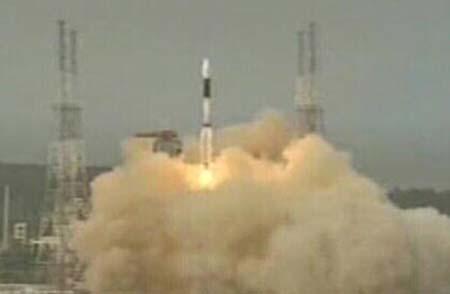India's geosynchronous satellite launch vehicle fails
2010-04-16 09:11 BJT
SRIHARIKOTA, India, April 15 (Xinhua) -- Indian Space Research Organization (ISRO) Thursday suffered a setback when the Geosynchronous Satellite Launch Vehicle (GSLV-D3), which was launched using an Indian-designed and built cryogenic engine for the first time, deviated from its path and thus failed.
 |
| In this frame grab taken from NDTV, the Indian GSLV-D3 rocket takes off from the Indian Space Research Organisation (ISRO) facility in Sriharikota, some 100kms from Chennai. Indian space engineers lost contact with the rocket showcasing new indigenously built booster technology soon after launch. (Xinhua/AFP Photo) |
"The control was lost as two small cryo engines did not ignite, " ISRO Chairman K. Radhakrishnan said here. "We will put all efforts to ensure that the next flight with the indigenous cryogenic engine takes place within a year."
The rocket deviated from its path and the scientists monitoring the launch said that they did not receive any speed and altitude data from the vehicle.
The rocket had lifted from the ISRO Satish Dhawan Space Center (SDSC) launch pad at Sriharikota island, off the coast of the southeastern state of Andhra Pradesh at 16:27 p.m. local time.
However, the launch was not perfect with the GSLV-D3 failing to send any data after 500 seconds of taking off.
The GSLV-D3 was to put the 2.2-ton communication satellite GSAT- 4 into the geo-transfer orbit (GTO) on Thursday evening.
Till now, ISRO had been using Russian cryogenic engines in its GSLV missions as the United States had forced Moscow not to sell the cryogenic technology to India in 1992 and it took India more than 18 years to develop this cryogenic engine as technology.
Only five countries - the United States, Russia, France, Japan and China - have the cryogenic engine upper stage technology to launch heavier satellites in geostationary orbit.
India is the sixth country to design and develop the cryogenic technology.

 Mail
Mail Share
Share Print
Print


 Video
Video









 2009 China Central Television. All Rights Reserved
2009 China Central Television. All Rights Reserved